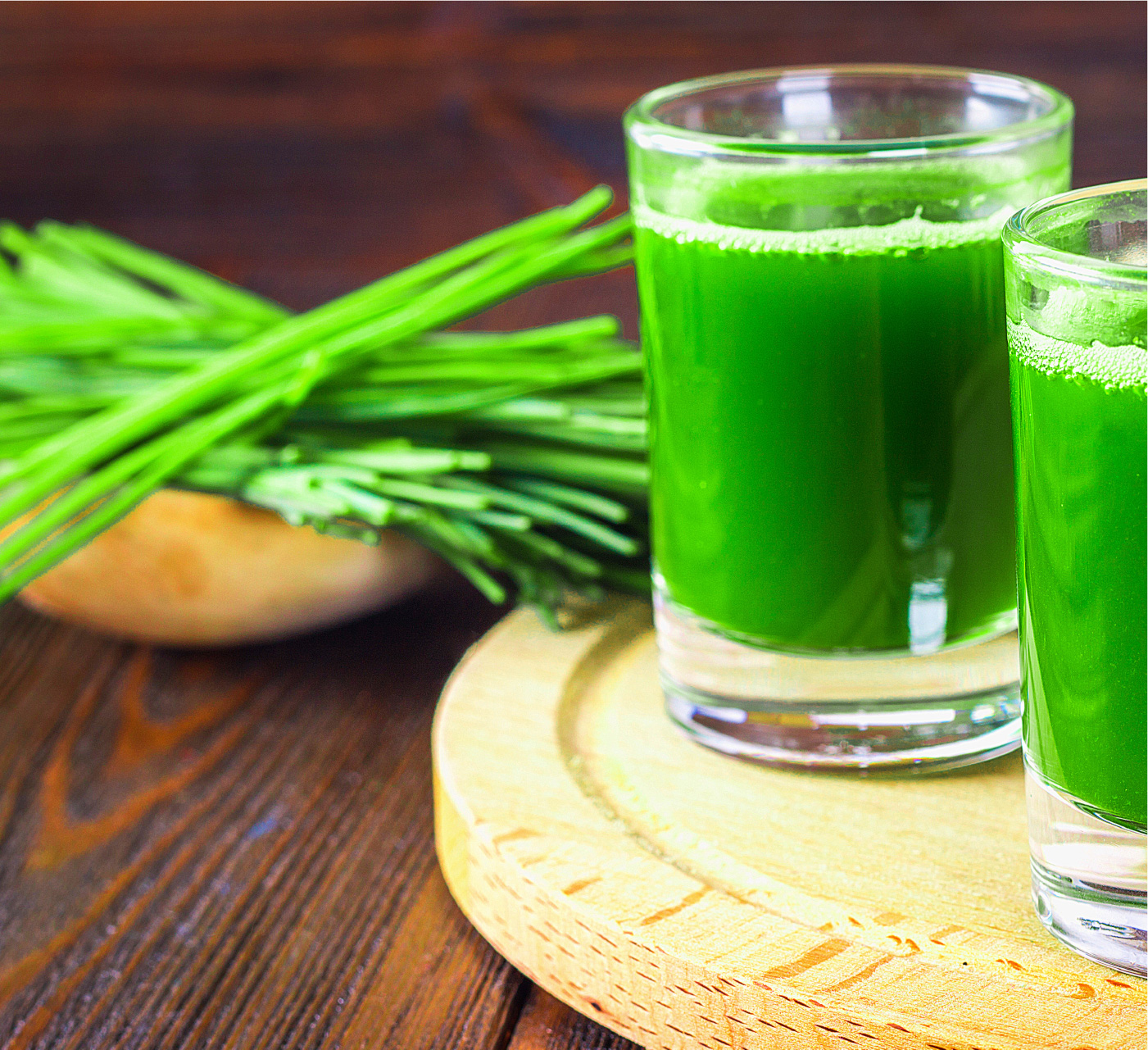Ashwagandha in Sanskrit means “smell of the horse” to correlate it with the strength of…
Read MoreWhat is wheatgrass and why is it considered a complete food, a superfood? The first leaves of the wheat plant contain densely-packed nutrients that have been used in holistic, traditional medicine for ages. Most people drink the fresh juice from squeezed tender leaves while some choose to add them to their salads and others prefer the powdered supplements. You can find it at most health juice bars or adorning the shelves of organic health stores.
The main ingredient in wheatgrass is the potent green pigment called chlorophyll. Considered hard to digest in its raw form, juicing is the preferred way to consume this superfood. Wheatgrass juice should be consumed fresh and ideally on an empty stomach in the morning. It also combats several health conditions, including cold, cough, fever, digestive problems, and skin conditions.
Though research on wheatgrass is limited, there is enough evidence that wheatgrass has the potential of being a daily health tonic. Let’s look at why wheatgrass has garnered the respect of the health-conscious community worldwide.
The production of toxins is a by-product of our body’s multiple biological processes. Elimination of these toxins is essential for the optimal functioning of critical body functions. Accumulation of these toxins results in oxidative stress which is responsible for a host of health issues, including heart disease, cancer, arthritis and neurodegenerative ailments. Wheatgrass is a treasure trove of antioxidants like glutathione, vitamin A, C, and E which prevent damage to cells by fighting free radicals that develop from oxidative stress.[1]Parit, Santosh B., Vishal V. Dawkar, Rahul S. Tanpure, Sandeep R. Pai, and Ashok D. Chougale. “Nutritional quality and antioxidant activity of wheatgrass (Triticum aestivum) unwrap by proteome … Continue reading The presence of other vital nutrients like iron, calcium, magnesium, and vital amino acids in wheatgrass make it a real superfood.
Cholesterol has received all the negative press and is generally associated with problems with your heart. But, this essential component is needed for a host of vital functions like building cell membrane structures, producing hormones, maintaining optimal metabolism, and aiding in the production of the supercritical vitamin D. Excess cholesterol levels in the blood, especially in LDL form is the primary cause of plaque buildup in the arteries called atherosclerosis that blocks blood and oxygen flow to the heart. Research has found that essential components of wheatgrass can lower LDL levels of cholesterol while boosting HDL (good cholesterol) levels.[2]Kothari, Saroj, Anand K. Jain, Swaroop C. Mehta, and Shrinivas D. Tonpay. “Hypolipidemic effect of fresh Triticum aestivum (wheat) grass juice in hypercholesterolemic rats.” Acta Pol … Continue reading
In the absence of a good detox system in place, the body will struggle with allocating its resources between fighting and flushing these toxins out and essential functions like growth and repair. Wheatgrass juice is packed with nutrients that detoxify your body and also trigger your metabolism to give the energy boost you need to fight off infections. Wheatgrass’ impressive nutritional profile includes amino acids, phytonutrients, antioxidants and other powerful minerals that build a strong immunity shield to ward off niggling everyday ailments as well as bigger lifestyle issues like obesity, cancer, etc. Its high fibre content keeps your digestion in peak form lending vital support to your immune buildup.
Most people who vouch for the health benefits of wheatgrass are generally talking about its vaunted weight loss benefits. While there aren’t substantial studies to corroborate a direct link between wheatgrass juice and weight loss, it has a few things that can assist in melting stubborn fat. One key factor is thylakoids in wheatgrass that have shown to improve satiety keeping you feel fuller for longer. Another key is its high fibre content. Fibre flushes out toxins from your gastrointestinal tract, liver, and gall bladder ensuring optimum assimilation of food, and reducing fat deposits. Wheatgrass boosts your metabolism aiding in the efficient utilization of fat as energy.
Wheatgrass contains compounds that mimic the effect of insulin and help control blood sugar levels. It contains magnesium that boosts insulin responsiveness while lowering the glycemic index of foods in the body. The high fibre content in wheatgrass modulates sugar and cholesterol absorption in the blood. Studies have shown that the ethanolic extract of wheatgrass significantly lowered fasting blood glucose, serum triglycerides levels, and LDL cholesterol levels while boosting HDL (good) cholesterol levels.[3]Mohan, Yogesha, Grace Nirmala Jesuthankaraj, and Narendhirakannan Ramasamy Thangavelu. “Antidiabetic and antioxidant properties of Triticum aestivum in streptozotocin-induced diabetic … Continue reading
Wheatgrass, in its raw form, can be hard to digest so juice or powder is the preferred form of consumption. Wheatgrass supports the gut with beneficial enzymes (protease, lipase and cytochrome oxidase) that help in breaking down complex carbs, proteins and fats and improves the absorption of nutrients. Kapiva’s wheatgrass juice is a potent detoxifier that cleanses your gastrointestinal tract off accumulated toxins, keeping digestive issues like gas, bloating, etc away. Fibre-rich wheatgrass provides enough roughage to assist in smooth bowel movement and keeps you free of constipation. Alkaline minerals in wheatgrass powder modulate the acidic content in the gut preventing ulcers and diarrhoea.[4]Rana, Satyavati, Jaspreet Kaur Kamboj, and Vandana Gandhi. “Living life the natural way–Wheatgrass and Health.” Functional foods in health and disease 1, no. 11 (2011): 444-456.

How much wheatgrass juice to consume for best results depends on multiple factors. If you are just starting off we recommend you start slow and see how your body reacts and adapts to this new food. Typical safe and effective consumption levels are around 30ml to 120 ml a day in juice form or 3gms to 5 gms in powdered form. Another factor to note is age and your specific requirements. Check the chart below to find what suits you best:
As a general daily tonic:
1. Children: Not more than 25ml
2. If you are < 50 years of age: 25ml to 55ml for women and between 55ml to 80ml for men
3. Above 50 years: 55ml to 85ml for women and between 85ml to 110ml for men
Seeking relief from certain ailments like weight loss, etc.:
1. 110 to 140 ml per day for 8 weeks.
For all the above dosages dilute wheatgrass juice in an equal quantity of water. Also flushing it off with 250 ml of water will keep some of the side effects at bay. Generally, your body would need a minimum of 2 weeks to try to adapt to side effects like headache, fever, nausea, upset stomach and/or constipation. If the side effects still persist you can decide to lower the dosage or stop it completely.
As with any new food, consult your doctor to check if this contradicts any specific medications or ailments/allergies that you already have. Wheatgrass juice is not recommended if you are pregnant or breastfeeding.
Wheatgrass will get to work on multiple fronts inside your body.
– Cleansing the body of toxins,
– introducing beneficial enzymes in the gut to break down complex carbs, proteins and catabolizing fats,
– improving absorption of nutrients from food,
– lowering your blood sugar levels,
– controlling your blood pressure levels,
– increasing your red blood cells,
– fighting fat accumulation,
– improving overall energy levels,
– improving your digestive system.
Do check this video to learn more about the amazing cleansing properties of Kapiva’s wheatgrass juice:
Incorporating one of nature’s simplest gifts into our lives is an absolute no brainer. Considering how easy it is to grow at home, even on a small window sill, makes it the most accessible superfood there is. The green juice is considered a ‘living food’ with energetic minions within it ready to undo a lot of the abuse that our bodies have suffered due to our unhealthy lifestyle.
Yes. There are few documented side effects of the consumption of wheatgrass juice, making it a safe superfood. It is also suitable for a wide range of age groups. It is low in calories and high in nutrients making it an ideal daily health tonic.
Wheatgrass is beneficial for multiple health issues like reducing bad cholesterol, lowering blood sugar levels, improving oxygen and blood circulation, boosting energy levels, eliminating digestive issues like constipation and ulcers and increasing red blood cell count.
You can have a minimum of 30ml of wheatgrass juice daily diluted with the same amount of water. Start with the minimum and then increase if you seek specific ailment related relief. Allow 2 weeks for any side effects to settle, for your body to adapt, and for any visible changes. You can have a maximum of 120 ml (4oz) juice daily.
Yes. Wheatgrass is recommended for a variety of skin ailments from acne to dark spots, and for treating skin diseases like eczema and psoriasis. It is a natural detoxifier and its skin-nourishing vitamins A, C and E help protect vital collagen.
While mild symptoms like nausea, digestive issues, mild fever, and headache are common, wheatgrass is not recommended if you are pregnant or breastfeeding. Consult your doctor to check if wheatgrass is safe to consume along with your diabetes medication as wheatgrass will decrease your blood glucose levels.
References
| ↑1 | Parit, Santosh B., Vishal V. Dawkar, Rahul S. Tanpure, Sandeep R. Pai, and Ashok D. Chougale. “Nutritional quality and antioxidant activity of wheatgrass (Triticum aestivum) unwrap by proteome profiling and DPPH and FRAP assays.” Journal of food science 83, no. 8 (2018): 2127-2139. |
|---|---|
| ↑2 | Kothari, Saroj, Anand K. Jain, Swaroop C. Mehta, and Shrinivas D. Tonpay. “Hypolipidemic effect of fresh Triticum aestivum (wheat) grass juice in hypercholesterolemic rats.” Acta Pol Pharm 68, no. 2 (2011): 291-294. |
| ↑3 | Mohan, Yogesha, Grace Nirmala Jesuthankaraj, and Narendhirakannan Ramasamy Thangavelu. “Antidiabetic and antioxidant properties of Triticum aestivum in streptozotocin-induced diabetic rats.” Advances in pharmacological sciences 2013 (2013). |
| ↑4 | Rana, Satyavati, Jaspreet Kaur Kamboj, and Vandana Gandhi. “Living life the natural way–Wheatgrass and Health.” Functional foods in health and disease 1, no. 11 (2011): 444-456. |


We are a team of food scientists and Ayurveda experts at Kapiva. Our mission is to raise awareness and educate people on ancient principles and herbs found in traditional texts. We work together to develop the most comprehensive content on Ayurveda which is grounded in peer-reviewed, scientific research.

Ashwagandha in Sanskrit means “smell of the horse” to correlate it with the strength of…
Read More
Your liver is an important organ that is vital for your health. It performs a…
Read More
We’ve heard Yoga is beneficial to our physical and mental wellbeing. There are very well…
Read More
Over the past few years, the word detox has grown in popularity, with many adding…
Read More